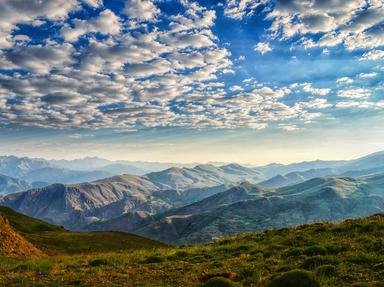Quiz Answer Key and Fun Facts
1. It was a long and hard climb, but I had finally made it to the mountaintop. As I stared down, I wondered how I ever made it to the mountaintop. The mountaintop was almost 30,000 feet above sea level, after all.
Hmm, perhaps I have overused the word "mountaintop". Which of these words is an equivalent term for "mountaintop"?
2. When I reached the top, I found a local shelter. This is where I stayed warm for the night. During the night however, I heard some screeching. The locals told me stories of a great beast who lived in these mountains. They called it "The Yeti".
It is fairly common knowledge that Mount Everest is in the Himalayan Mountains. However, what section of the Himalayas contains Everest?
3. The yeti. I'd heard of it. I remembered learning about it in my Cryptozoology Studies while in Oxford. I didn't believe it existed but the locals' stories had begun to convince me.
I keep referring to the people of Nepal as "locals". Perhaps, to make things more interesting, I'll mention the city they are from. Which of these is a city of Nepal?
4. Someone had eavesdropped on my conversation with one local man and began to speak up. "The yeti. I came here looking for that creature." Upon further discussion I learned that he was a scientist from one of the core wards of Tokyo.
Which of these special wards of Tokyo is not considered one of the "core wards"?
5. I was now intrigued by this so-called "yeti", and I had to investigate. I agreed to help. "Great, we'll head off first thing in the morning; five o'clock sharp." Bleh. I was not a morning person. Still, I agreed, and the next day we packed up our equipment and headed down the mountain.
Local sherpas know the Yeti by many names. Which of these is not such a name for the abominable snowman, as it is a name used for a local type of bear?
6. It was nearly a full day's journey to our first marker. Though it was still early in the evening, we set up camp in an abandoned cave. I was told it got cold in the night, so we couldn't stay out long during the day. The den proved to be a very useful shelter.
Besides the extreme cold, Mount Everest has several other deadly risks associated with it. Which of these is NOT one of the threats of Everest?
7. When I awoke, I discovered the man I was with (who had yet to tell me his name) was already up and working. He seemed to be using a device to listen to something, but I heard nothing. When he saw me, he told me that our location was not capturing any yeti sounds, and we had to move. We left our warm den and continued our trek across the massive mountain.
Speaking of massive mountains, perhaps I could mention the local name of Everest, just to give the story a little flair. By what other name is Mount Everest known?
8. I had troubles not slipping on the frozen ground as we journeyed across the mountain but my biggest trouble was when I stepped on ice and heard a crack. Suddenly, the solid ground below us collapsed and we found ourselves at the bottom of a giant crack in the mountain. We were deep in the hole.
The crack was formed from an ice sheet on Everest. What was this crack called?
9. Though we were in a hole and the top seems a million miles away from me, the scientist did not seem to worry. Instead, he went over to a column of ice created by two intersecting cracks in the surface.
These ice formations actually have their own name. What name do they go by?
10. Fortunately for me, the scientist was prepared in case we ever fell in a crack such as this. He pulled out some icepicks and we scaled the walls until we were out of the hole. When we got out, my extreme thirst began kicking in. I started to eat some snow, but Ming (as I have now learned his name) batted it away and told me not to eat it.
What gives? I can eat snow for water, can't I? Is it a good idea to eat snow or ice in cold climates to stay hydrated?
Source: Author
salami_swami
This quiz was reviewed by FunTrivia editor
Tizzabelle before going online.
Any errors found in FunTrivia content are routinely corrected through our feedback system.
